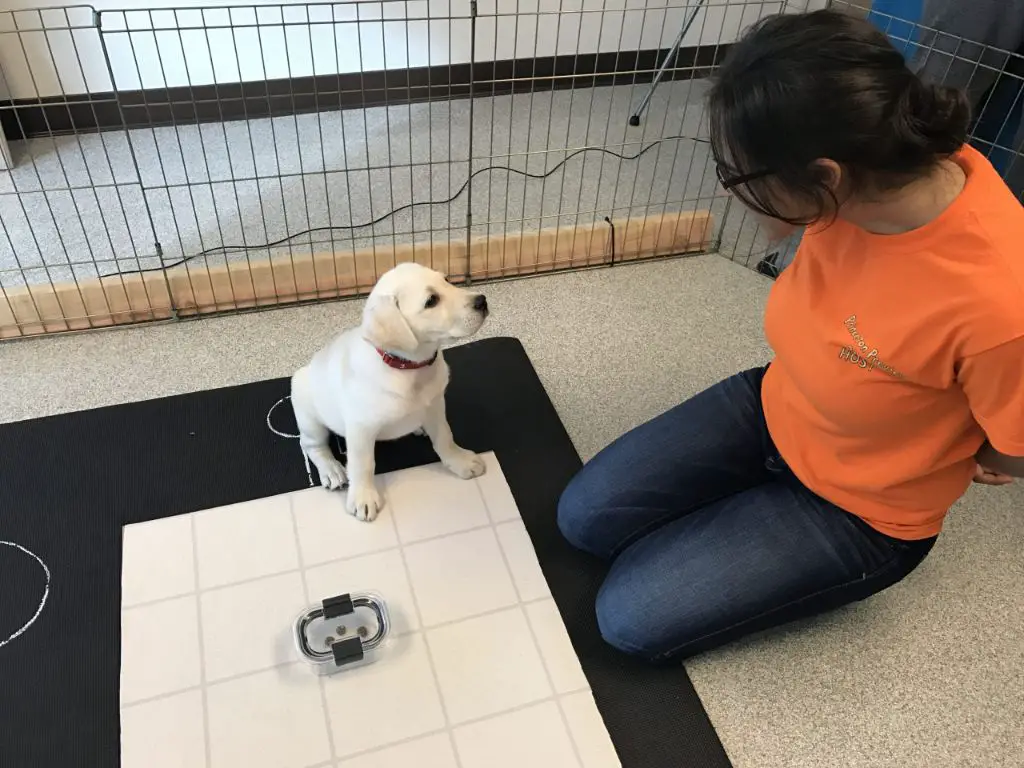Do Dogs Think and Communicate in the Same Way Humans Do?
Some dog owners swear their pets know exactly what they’re saying. When you tell your dog to “go get the ball” or “time for walkies,” they seem to understand every word and happily oblige. But is your dog really processing language the same way you do? Do Fido and Rover hear English words and translate them into a doggy understanding, or are they simply responding to familiar sounds and reading your body language?
This article will examine how dogs think and communicate compared to their human companions. We’ll explore the canine brain, the different ways dogs express themselves, their ability to recognize words, and more. You may be surprised to find out dogs don’t think in any language at all, but they comprehend us better than we comprehend them.
The Dog’s Brain
While a dog’s brain is smaller than a human’s brain, it has similar structures and functionality. The main parts of a dog’s brain are the cerebrum, cerebellum, and brain stem, which also exist in the human brain. The cerebrum is the largest part of a dog’s brain and controls complex cognition and behavior. The cerebral cortex makes up the outer layer of the cerebrum and is associated with thinking, planning, and personality in both humans and dogs. The cerebellum coordinates movement and balance. And the brain stem connects the brain to the spinal cord and controls automatic functions like breathing and heart rate.
Dogs have fewer cortical neurons than humans and less developed frontal lobes. The frontal lobes play an important role in complex thought, decision making, and social behaviors in humans. Since dogs have smaller frontal lobes, they likely cannot plan or think abstractly to the same degree as humans. However, dogs still demonstrate impressive learning abilities, emotion, memory, and self-awareness. So while a dog’s cognition differs from a human’s, their brain still enables complex mental processes that allow dogs to communicate, form relationships, and understand words and commands.
Dog Communication
Dogs communicate in many different ways. One of the most well-known is through barking. Dogs have a wide range of barks that convey different meanings and emotions. Short, quick barks often signal alarm or excitement. Low pitched barks can be a warning sign. Howling is another vocalization for dogs, usually used to signal distress or loneliness. Growling demonstrates aggression or a defensive attitude.
Dogs also communicate through body language. A wagging tail usually conveys a friendly demeanor, while a stiff, upright tail often signals dominance or aggression. Submissive or fearful dogs may hold their tails low and tucked between their legs. Facial expressions, ear positioning, and eye contact also give behavioral cues. Dogs communicate with scent through urine and gland secretions. They also interact through touch, using paw placements, nudges, and body leans.
Human Language vs Dog Communication
There are key differences between human language and dog communication. Human languages like English or Mandarin have complex grammar rules, expansive vocabularies with exact meanings, and intricate syntax that allows us to communicate complex ideas. Dogs do not have language abilities anything close to humans.
Human language utilizes words and combinations of words that act as symbols to represent precise meanings. We learn these word-meaning connections through extensive vocabularies. Dogs do not use words or grammar in their own communications. They can learn to recognize some human words through training, but they do not have vocabularies or grasp the same complex meanings of words that humans do.
Another key component of human language is syntax – the set of rules for how words should be arranged to form sentences and convey ideas. Humans use syntax patterns like subject-verb-object to build sentences that can communicate intricate concepts. Dogs do not employ syntax or arrange sounds in ways that denote advanced meaning.
While dogs can learn to associate some human words with actions through repetition, they do not have an innate capacity for human language. Their own communication methods of barks, body language, and scent lack the complexity and expressiveness of human language. When it comes to advanced language skills, there remains a clear separation between humans and even the cleverest canines.
Dog Word Recognition

Numerous studies have demonstrated dogs’ ability to learn the meanings of many human words. Dogs can learn the names of their toys and associate commands like “sit” and “stay” with the correct behaviors. However, research shows dogs mainly learn these words through conditioning and association, rather than understanding syntax or grammar.
Dogs do not perceive words as discrete semantic units that can be recombined in novel ways to express new meanings, which is fundamental to human language. While a dog may recognize the words “ball,” “park,” or “car,” there is no evidence they understand sentences by analyzing individual words and how they relate grammatically. Instead, dogs learn to associate words and phrases holistically with outcomes.
So while dogs show impressive abilities to learn human words, this does not mean they think in a human language. Their understanding is based more on interpreting our intentions than linguistic comprehension. It is unlikely dogs possess an internal monologue or “voice in their head” using human language words and grammar.
Imagery and Memory
Dogs have a remarkable ability to remember images and visual information. Their visual memory capabilities allow them to recognize locations, objects, animals, and people that they’ve seen before, often even after long periods of time.
There is also evidence that dogs have mental imagery and can visualize absent objects and locations in their minds. Studies have shown that dogs can rely on mental images to solve problems and navigate environments. For example, dogs are able to locate hidden food in experiments after only seeing the location visually once before. This suggests they formed a mental representation of the environment.

Dogs’ impressive visual memory and mental imagery allows them to remember complex information and situations. They can recall experiences, people, places, commands, and knowledge they’ve acquired, all through visual and mental constructs. Their reliance on visual thinking may be a key factor that sets dogs apart from even their closest canine relatives.
Training Dogs with Words
Dogs can be trained to respond to human words and language in remarkable ways. This is done through consistent positive reinforcement training, where dogs learn to associate certain words and commands with actions and rewards.
Some common examples of training dogs with words include:
- Basic obedience commands like “sit”, “stay”, “come”, “heel”, “down”, etc.
- “Leave it” to stop dogs from approaching certain objects or people
- “Quiet” to stop barking
- “Go to your crate/bed/place” to direct them where to go
- Names of toys to fetch specific items

With enough repetition and rewards, dogs learn to listen for these verbal cues and respond accordingly, showing an understanding of the meaning behind the human words. The words become a trigger for them to perform trained behaviors even when no other contextual clues are present.
This demonstrates that dogs have the cognitive capacity to associate human verbal commands with actions. While they don’t have an innate understanding of human language, dogs can learn to understand words the same way humans learn any new language.
Dogs Don’t Think in Language
While dogs can learn to associate certain words with commands, objects, and actions, they do not have an internal monologue or verbal thought process like humans. Dogs lack the physiological structures in the throat and mouth to produce the wide range of sounds that make up human languages. Their brains also process information differently than primates. Dogs do not have a specialized region of the brain dedicated to language processing.
Instead of thinking in words or sentences, dogs process information through visual and sensory associations. Their thoughts are more primitive and based on instinctual needs like eating, playing, and social bonding. Dogs learn by linking rewards like treats and praise with certain behaviors, not by understanding the verbal word itself. While they may recognize familiar words, dogs do not have an internal voice or dialogue.
Rather than contemplating their existence or making plans for the future, dogs are present-oriented and focus their mental energy on interpreting smells, body language, tones of voice and immediate needs like hunger or fear. They rely more on non-verbal cues and experiential learning than abstract linguistic thinking. So while dogs may understand us better than we understand them, they do not possess the same capacity for language that humans do.
Dogs Understand Us Better Than We Understand Them
Dogs have a remarkable ability to read and understand human nonverbal communication and body language. Studies have shown that dogs can recognize human emotions like happiness, sadness, anger and anxiety from facial expressions alone. Dogs are also very attuned to human eye gaze and pointing. If a human points or looks in a certain direction, dogs almost instinctively know to investigate that area.
In contrast, humans struggle to fully understand dog communication signals like tail wagging, ear positioning and barking. While we can pick up on basic cues like aggression and excitement, the subtle nuances in dog body language are often missed. Dogs have evolved over thousands of years to understand human gestures and emotions, whereas the language of dogs remains somewhat mysterious to us. We often misinterpret a dog’s signals, seeing aggression when the dog is afraid or assuming happiness when the dog is feeling anxious.
So while a dog may recognize the meaning behind our words and body language, we lack the same comprehension of a dog’s barks and body postures. Dogs have a distinct advantage over humans when it comes to cross-species communication. With a little training, we may be able to sharpen our “dog speak” skills. But for now, it seems dogs understand us a lot better than we understand them.
Introduction
Text for intro..
etc..
Conclusion
In conclusion, dogs do not actually think in any language that humans would recognize. While dogs are intelligent animals capable of communication, learning words, and imagining memories, they do not have an internal monologue or “voice in their head” the way humans do.
Dogs primarily communicate through body language, smells, vocal tones and facial expressions. They can learn to associate certain words with commands, objects or actions through training. However, they do not think in words the way humans do.
Rather than an internal voice, dogs are believed to think in sensory impressions, images and feelings. Their sense of smell in particular creates powerful memories and impressions. While we may never fully understand everything going on in a dog’s mind, they have proven themselves capable of understanding much of what we say – even if they don’t think about it in the same language.
